Auxiliary Units - Britain’s Underground Resistance Force
In the early summer of 1940, as German troops massed on the Channel coast of France in the aftermath of the Dunkirk evacuation and it looked pretty black for Britain, a secret resistance force was created. Secret groups, known as Auxiliary Units, would operate from carefully hidden operational bases and would carry out guerrilla warfare in the event of a German invasion of Britain. East Lothian had its own Auxiliary Units based in the areas around East Linton and Dunbar.
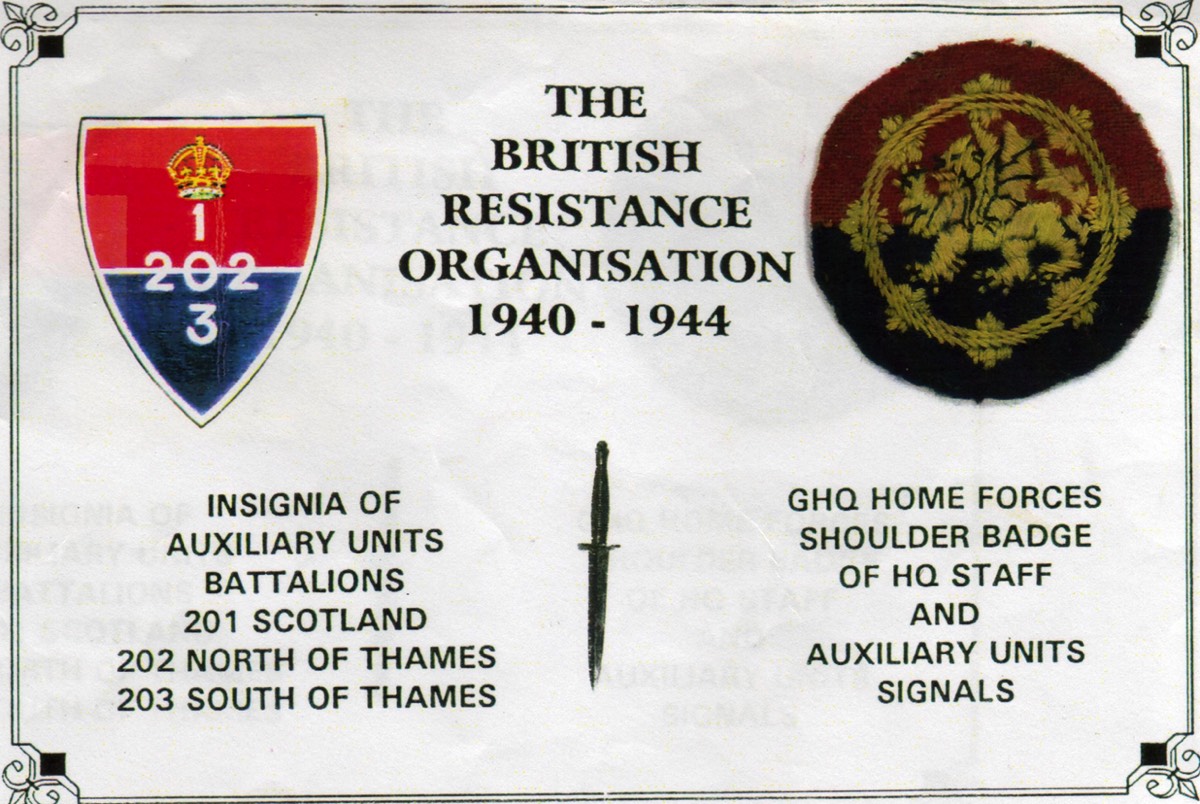
Insignia of the Auxiliary Units 201, 202 and 203.
Secret And Dangerous Work
Officially Auxiliers were represented as being in the Home Guard though they were unknown to local Home Guard Commanders. East Lothian’s Auxiliary Units were members of the 201st Battalion, Home Guard. In fact, the 201st Battalion never appeared on the official Home Guard lists, and thus the men were never official members of a military unit and would not have been entitled to the protection afforded to all uniformed fighting men under the Geneva Convention. Knowing the ruthlessness of the Nazi regime, any members of Auxiliary Units who had fallen into enemy hands would undoubtedly have been liable to execution.
To safeguard their own safety members were unable to tell anyone of their role and this level of secrecy was so tight that the existence of the Auxiliary Units was largely unknown to the wider public until the first UK reunion was held in Coleshill, near Swindon, on 30th November, 1994, the fiftieth anniversary of their stand-down.
Coverage has tended to assume that the Auxiliary Units were composed of two mutually supportive sections: a patrol/sabotage section and a radio communication section. We are led to believe by one of the latter that the two were separate and largely unknown to each other.
Arthur Grabbitas, ex-Royal Signals, Auxiliary Units, wrote:
“Auxiliary Units were in two parts – the patrols and the wireless networks. All media attention has focussed on the patrols, probably, because of the secrecy involved, they were not aware of the networks! From my practical experience the patrols and wireless networks were completely separate. Where any connection has been made in the media it has suggested that the Signals provided communications for the patrols but that is definitely not true.”
Arthur’s information is that the Auxiliary Units were unaware of the Wireless/intelligence gathering Units. He continued:
“I was one of these [Royal Signals men who maintained the Auxiliary wireless networks, but] …the organisers of the reunion [in 1994] did not know of the wireless networks and I had difficulty in attending as they thought Signals were based at HQ …fortunately I still had my field passes and was able to attend, finding I was the only Signals person present”.
East Linton Auxiliary Unit
Scotland, being known as No 1 Region, had its headquarters in an underground bunker in East Lomond Hill in Fife. East Lothian was part of No.4 (Border) Area, whose headquarters was given as “c/o G.P.O. Newtown St Boswells, Roxburghshire” and one of the best units in that area was the East Linton area Patrol, which had its underground operational base at Janefield Wood (one mile north west of East Linton and 300 yards from the B1377) and a food store on Drylaw Hill. The hideouts were built by Royal Engineers brought north from England who were returned south immediately after the work was finished.
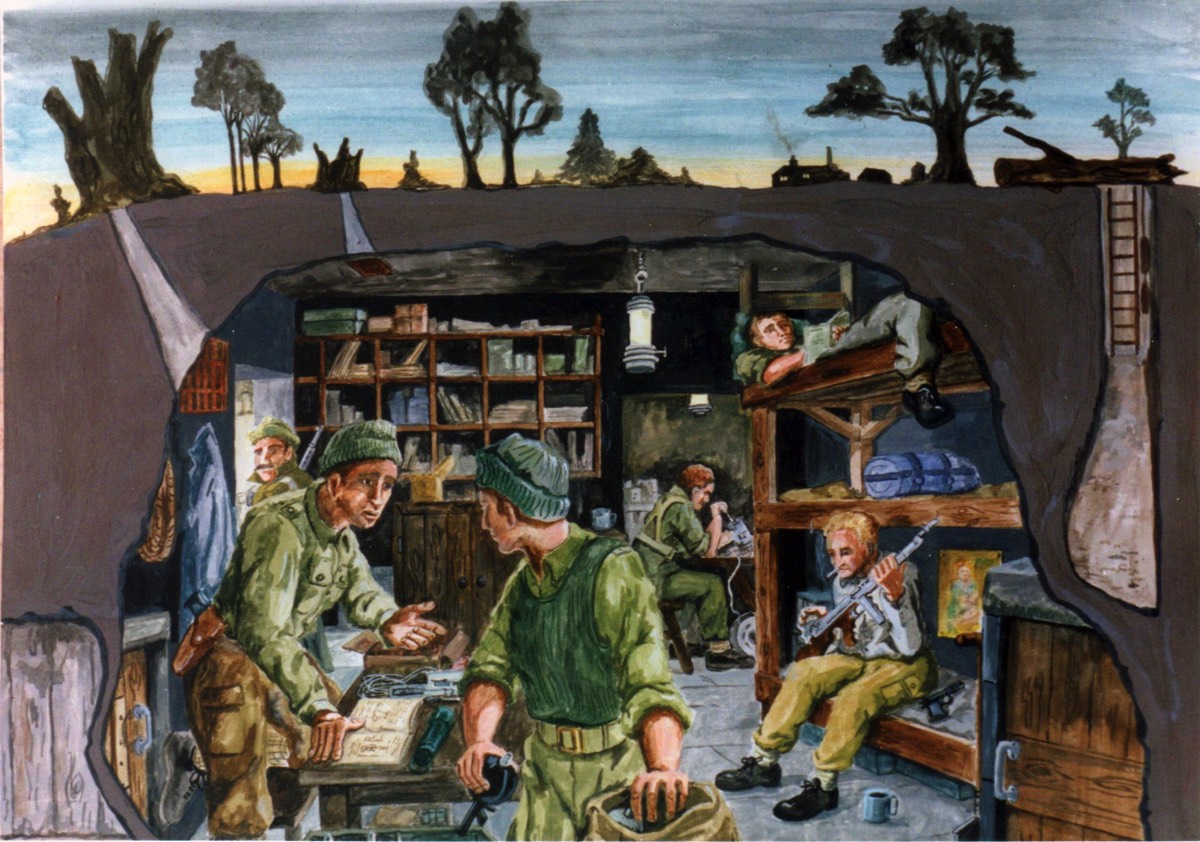
A recreation of what the Auxiliary Home Guard bunkers may have looked like.
The Operational Base (O.B.) at Janefield was built from corrugated iron sheets and measured roughly six by three and a half metres and was accessible via a vertical brick lined shaft. The O.B. contained six bunk beds, shelving and a cupboard and it was at this underground hideout that members of the East Linton Patrol would have assembled had an invasion taken place. Here, their arms, ammunition, explosives and rations would have been stored, ready for a time when East Lothian was under enemy occupation. Perhaps for a while the members of the East Linton Patrol would have remained at their normal jobs but at some point, they would have gathered in Janefield to emerge under the cover of darkness to carry out acts of sabotage before disappearing back into its well-concealed O.B.
East Linton Area Auxiliary Unit personnel
East Lothian’s Auxiliary Units (both Patrol/sabotage & Wireless or Special Duties) were made up of farmers, market gardeners, a teacher, a banker, and a joiner, assisted by a minister.
The East Linton area Patrol/Sabotage Unit comprised:
Sergeant George Davidson
Corporal Adam Middlemas
Private Charles Spence
Private Wullie Johnston
Private Willie Oldershaw
Private Jock Grant
Private James Watt
Corporal Adam Middlemas
Private Charles Spence
Private Wullie Johnston
Private Willie Oldershaw
Private Jock Grant
Private James Watt
- Farmer, Sunnyside Farm
- Farmer, Creuchie Farm
- Farmer, Beil Farm (Charles’ Obituary can be viewed below)
- Farm Worker, Markle Mains Farm
- Market Gardener
- Market Gardener
- Joiner
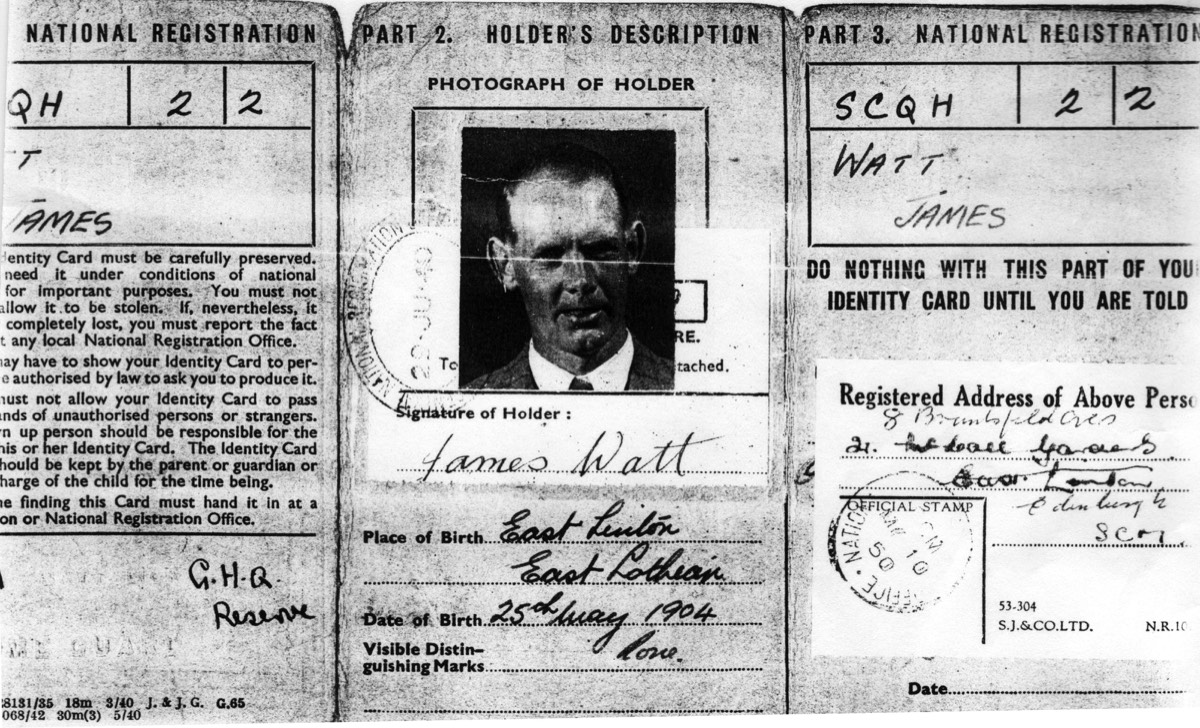
The ID Card of Private James Watt, East Linton Auxiliary Unit.
Auxiliary Special Duties (Signals) Unit, Smeaton Wood
Wireless communication of intelligence information to the ‘mother’ station on Blackhill in Edinburgh was handled by three men under the call sign ‘Bannock 3’. They would have sent and received messages from their communications base hidden in the woodland near the entrance to the present-day Smeaton Gardens. This hideout was constructed of concrete with two rooms: one for equipment and furniture, the other for communications equipment. Along one wall were pigeonholes containing booklets giving details of German units and equipment. In one pigeonhole was a concealed switch, which could open a small annexe, which contained the radio equipment. Their aerial, like most others, was probably run up the trunk of a tall tree, one with few branches to allow any enemy easy access and with helpful dark, water trails running down to help disguise the wire.
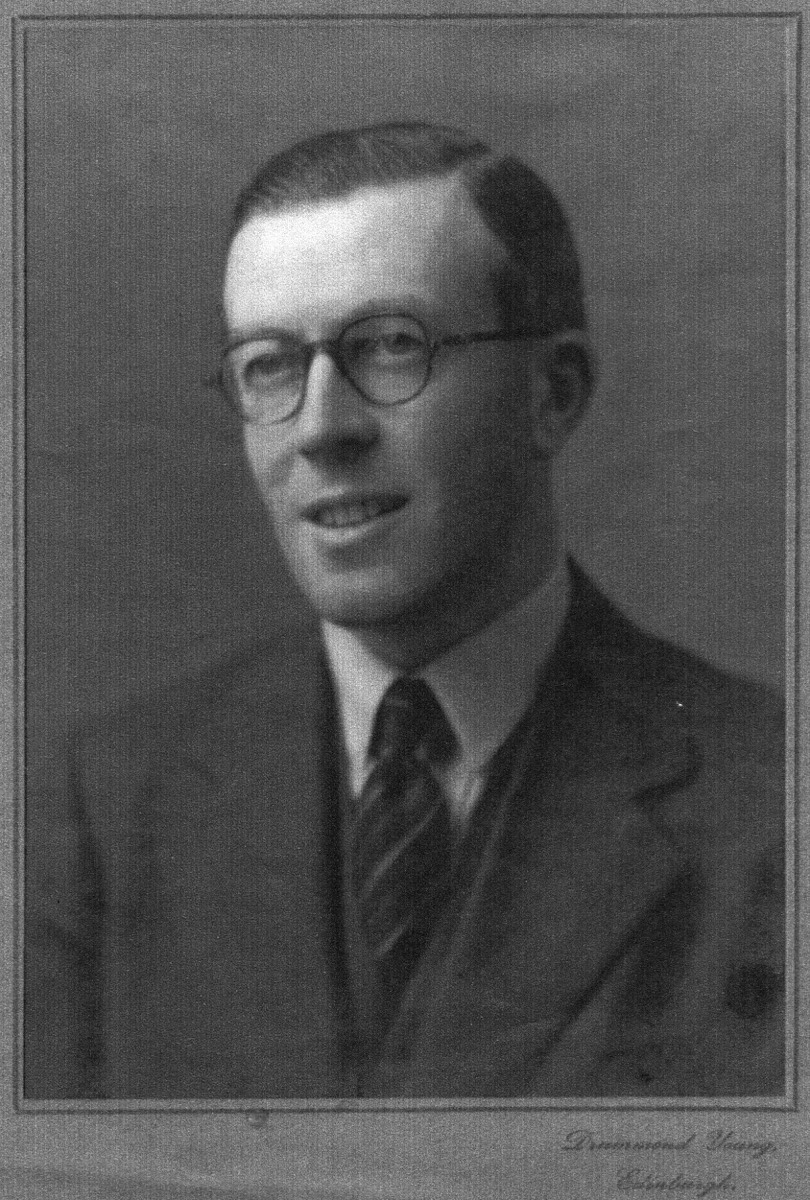
Alex Niven, 1940s.
We know that the East Linton area Wireless/intelligence unit was comprised of:
Mr Alex Niven - Lawhead
Mr James Grieve - Schoolmaster at East Linton
Reverend Souter - Minister at Whitekirk.
However, given the secrecy surrounding the Unit it is possible that there was a fourth member: William Middlemass, cousin of Adam. Reverend Souter acted as runner.
In an interesting glimpse into the secrecy surrounding the Auxiliers, Alex Niven’s daughter, a Mrs Gardiner, told interviewers in 1998 that:
“Mrs Niven and the family knew that Mr Niven had been involved in something but not what – Mrs Gardiner jokingly said that her mother wondered if he was seeing another woman! They thought that he was in the ARP but not the Home Guard.”
Rather more interestingly Mrs Gardiner showed that the East Linton area’s unit‘s anonymity wasn’t quite what it was cracked up to be when she revealed that:
“[The family] knew that other members of whatever he was in were the Minister at Whitekirk, James Grieve, the Headmaster at East Linton and [that] they had a runner who was nearly of Olympic standard. Mr Niven was involved from 1942 to the end of the war. When he went out, he used to vary his route – sometimes he would walk, sometimes he would cycle and sometimes he went via Smeaton.”
Clearly the family was not aware that the Rev. Souter himself was the runner in question.
Mr Alex Niven - Lawhead
Mr James Grieve - Schoolmaster at East Linton
Reverend Souter - Minister at Whitekirk.
However, given the secrecy surrounding the Unit it is possible that there was a fourth member: William Middlemass, cousin of Adam. Reverend Souter acted as runner.
In an interesting glimpse into the secrecy surrounding the Auxiliers, Alex Niven’s daughter, a Mrs Gardiner, told interviewers in 1998 that:
“Mrs Niven and the family knew that Mr Niven had been involved in something but not what – Mrs Gardiner jokingly said that her mother wondered if he was seeing another woman! They thought that he was in the ARP but not the Home Guard.”
Rather more interestingly Mrs Gardiner showed that the East Linton area’s unit‘s anonymity wasn’t quite what it was cracked up to be when she revealed that:
“[The family] knew that other members of whatever he was in were the Minister at Whitekirk, James Grieve, the Headmaster at East Linton and [that] they had a runner who was nearly of Olympic standard. Mr Niven was involved from 1942 to the end of the war. When he went out, he used to vary his route – sometimes he would walk, sometimes he would cycle and sometimes he went via Smeaton.”
Clearly the family was not aware that the Rev. Souter himself was the runner in question.
In an interesting, if sad, postscript the Rev. Souter was to disappear from his home in Howe Street, Edinburgh, on the 8th August 1959 and was never seen again.
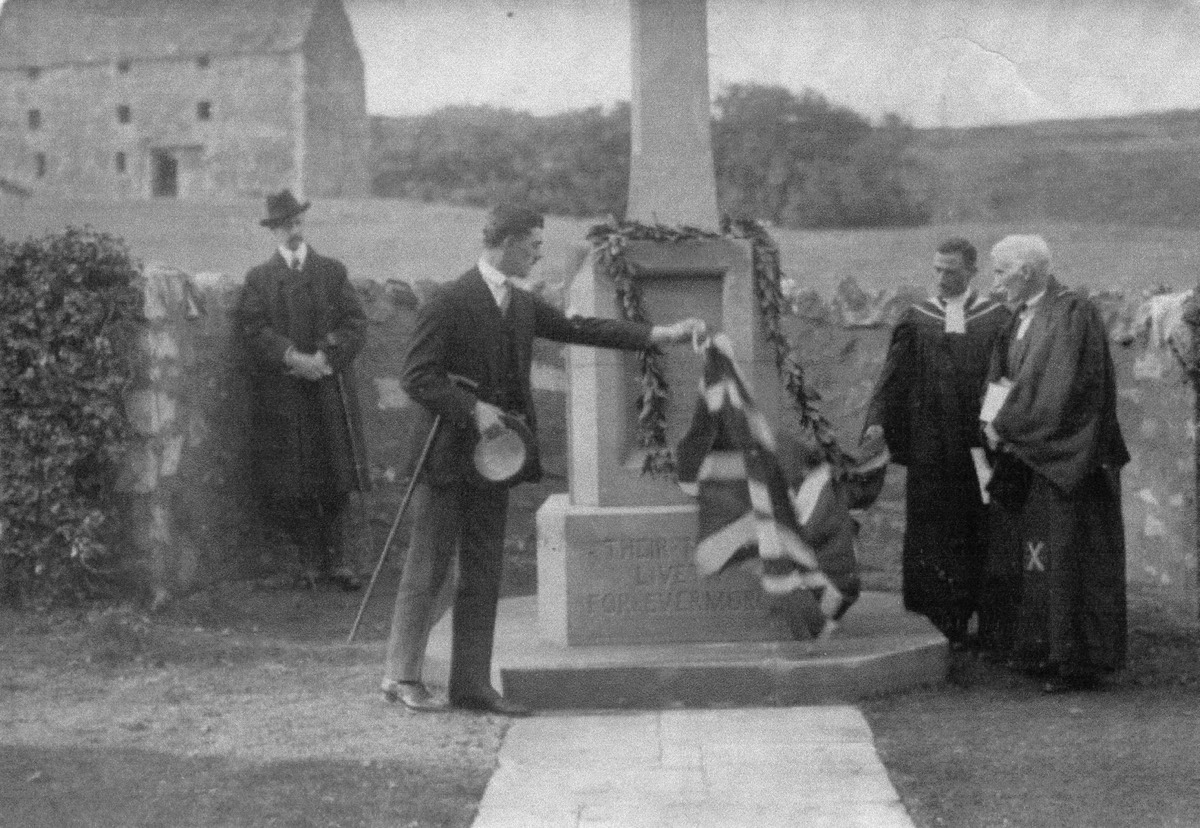
The Reverend James Tindall Souter assisting at the opening of the Whitekirk War Memorial in 1923.
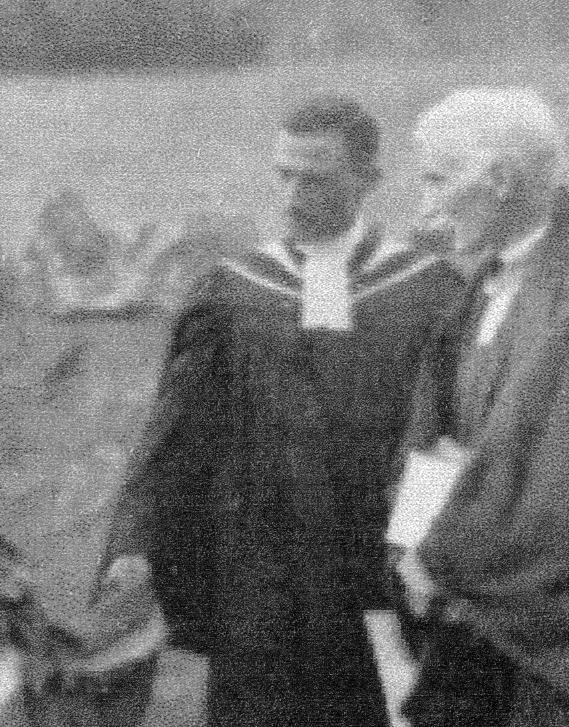
The Rev, Souter, left.
Dunbar Area Auxiliary Unit
Dunbar area’s Auxiliary Patrol/Sabotage Unit had its Operational Base at Little Spott, in a small quarry two miles south west of Dunbar, with its approach through a hole in a stone wall, west of Pleasance. Balfour Strang described;
“There were two actual bunkers connected by telephone, the entrance stone to one being still visible.” He continued, “My father blocked the main entrance to the bunker (dungeon he called it) with a boulder and bricked up the other entrance to keep people out. But, being inquisitive, I dug under the brickwork and got inside.” Balfour confirmed the reluctance of the Auxiliers to talk about their work when he noted “My father was rather reluctant to talk about what he did during those years and getting information from him was difficult…”
The entrance was skilfully disguised. This placed the East Linton and Dunbar units only some four miles apart.
Dunbar Area Auxiliary Unit Personnel
Second Lieutenant W Glenn Aitken
Corporal John Thorburn
Private Francis R. (Bertie) Strang
Private Gavin Strang
Private Jack Denholm
Private Alan Cockburn
Private Sives
Private Sives
Corporal (by then, Sergeant) Thorburn took over from Glenn Aitken when the latter suffered severe burns when phosphorous went off in his pocket.
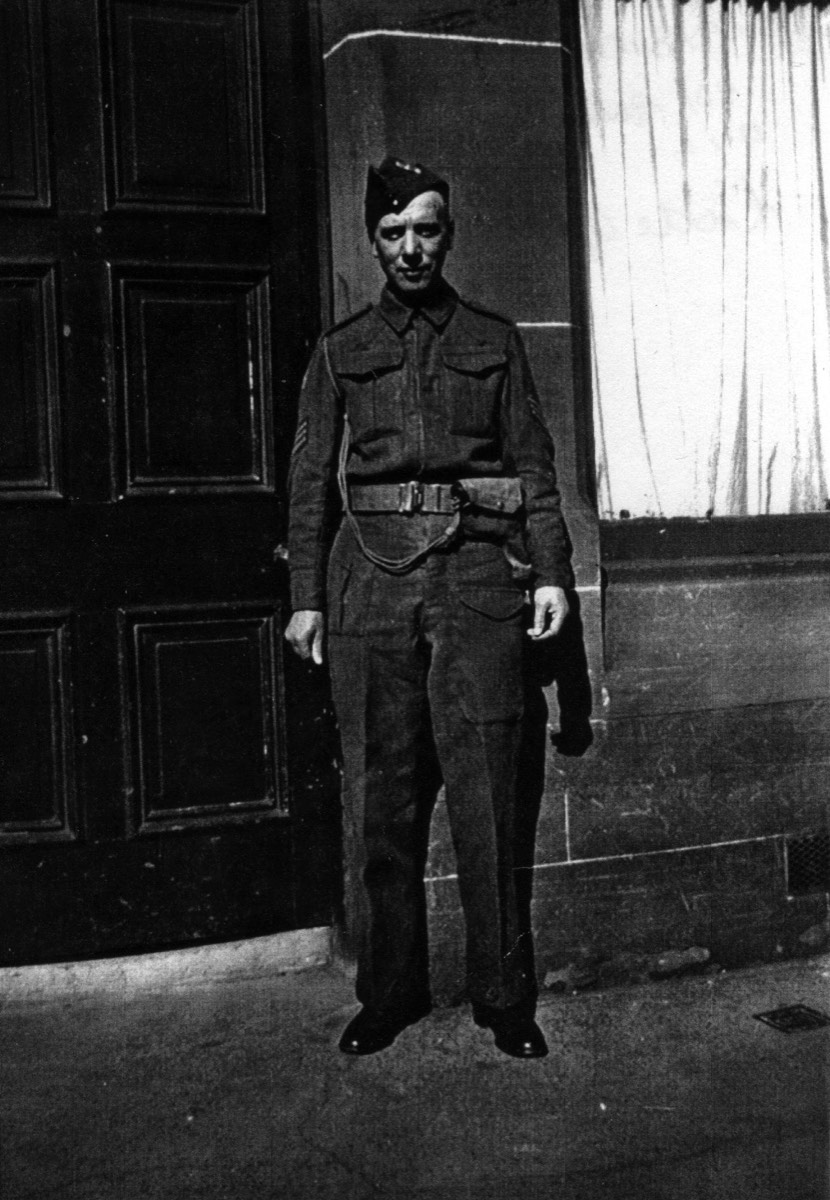
Sergeant John Thorburn.

Second Lieutenant W. Glenn Aitken.
Training
In order to give the East Linton Area Patrol the skills they would have needed, extensive training was carried out. All were trained in the use of firearms, demolition and the varying techniques of sabotage. They were also issued with detailed information on the recognition of German tanks, weapons, uniforms and insignia, aircraft and so forth. Evidently Auxiliary Units were intended to act as intelligence gathering bodies as well as saboteurs.
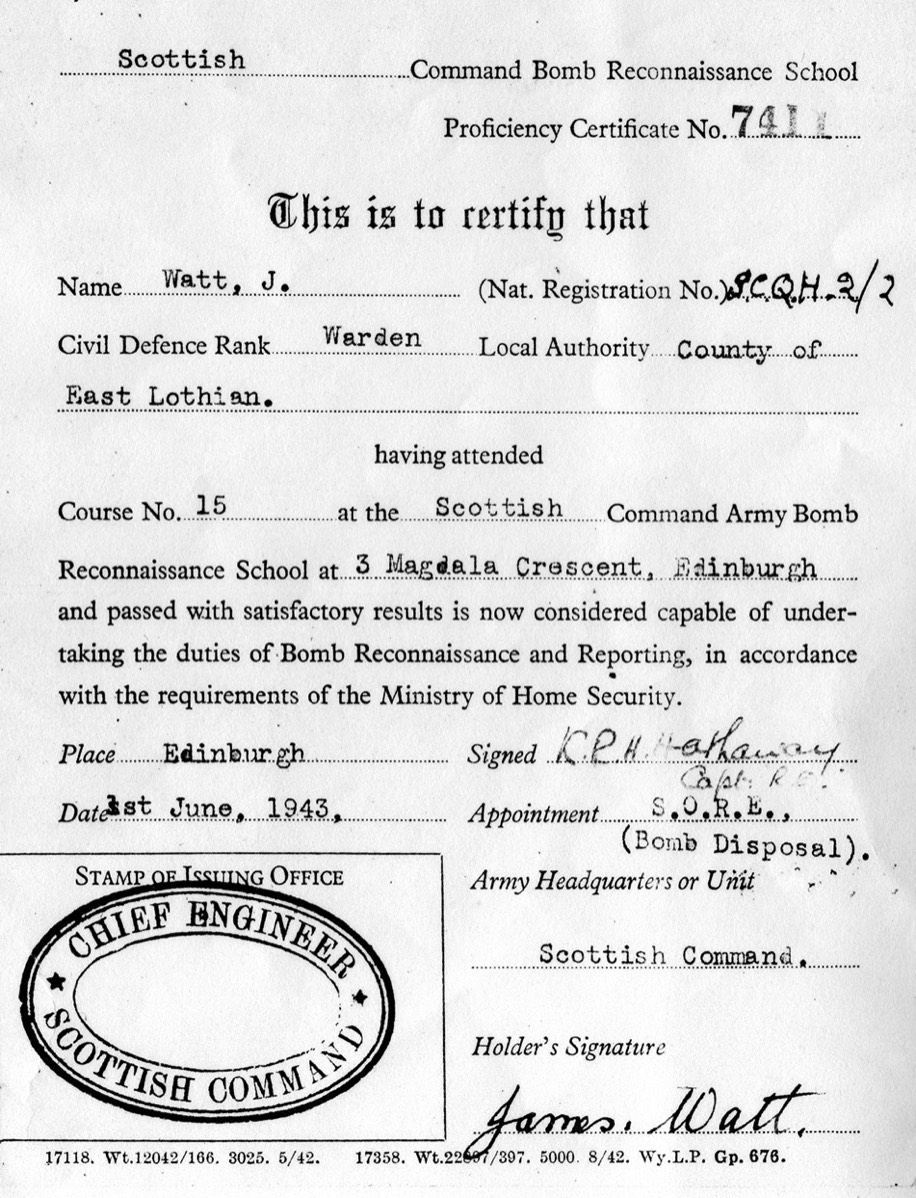
James Watt’s certificate in Bomb Reconnaissance and Reporting, June 1943.
Skills learnt in training were polished through competitions. In Area competitions a team from the East Linton Patrol, comprising Sergeant George Davidson and Privates Adam Middlemass and Charlie Spence, came third in the No.4 (Border) Area Shooting Competition during July/August 1943. Sergeant Davidson achieved third place equal in the Individual Area Efficiency Tests by scoring 98.2%. Sergeant Davidson also gained first place in the Area in the Third Home Guard Patrol competition, as a result of which he represented the Area in the semi-finals for Britain held at Coleshill House in Wiltshire, the Headquarters of the Auxiliary Units organisation, subsequently coming third against all units from all over the country.
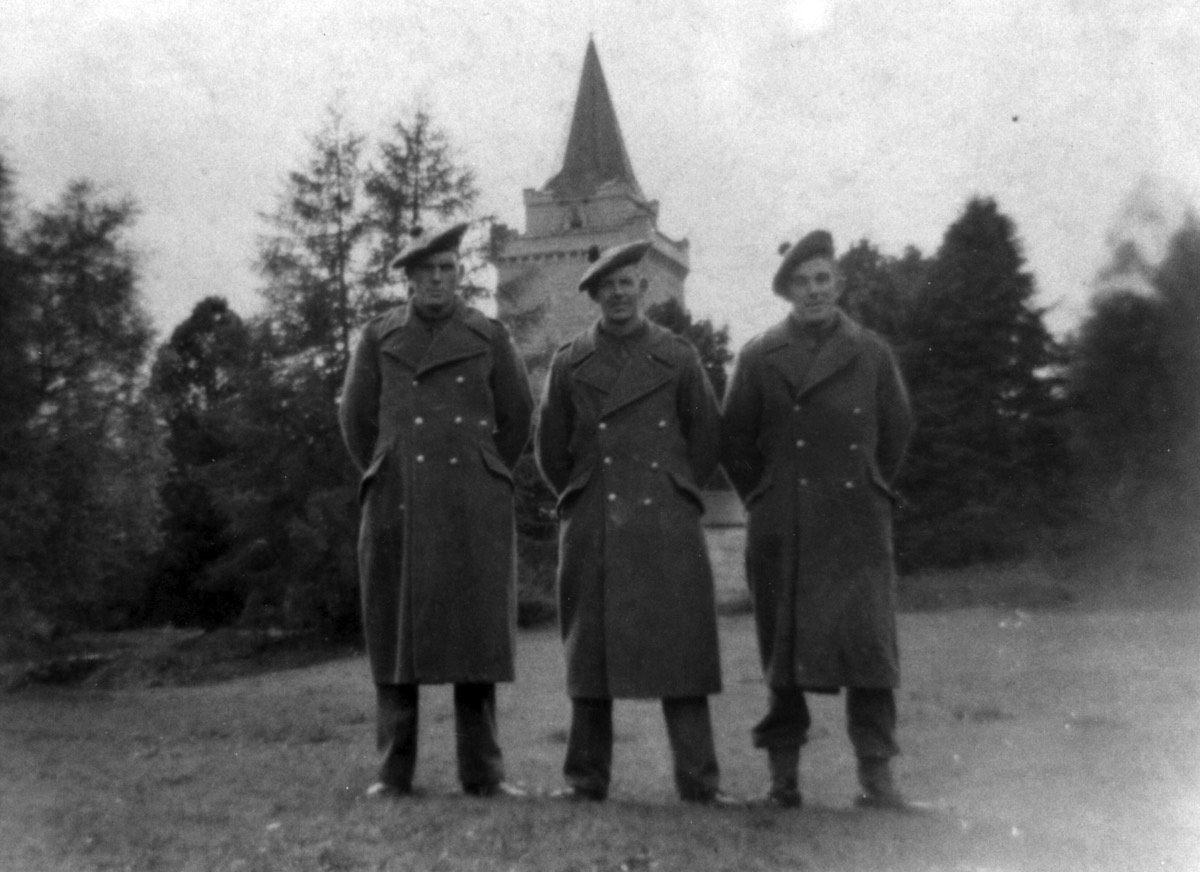
Members of the East Lothian 201 Auxiliary
Home Guard at Balmoral in 1942.
Deployment
A party of East Lothian Auxiliaries was posted south for two weeks around the time of the Normandy invasion in 1944. According to George Davidson they were informed that they were to be ‘sent overseas’, something, which, he said, “rather worried them”! In fact, ’overseas’ they went but only to the Isle of Wight. Major General Curtis, the Commander of the Hampshire and Dorset District sent a letter of appreciation, which eventually arrived in the hands of Sergeant Davidson.
In it he wrote:
“I wish to add my appreciation of the work of Auxiliary Units who have been in this District, both in the Isle of Wight and in Dorset, during the past few weeks. They fulfilled cheerfully and conscientiously a very important role and I am only sorry, for their sake, that they had no opportunity to practise it.”
On another occasion a number were sent to help guard the Royals at Balmoral.
Stand Down
In November 1944, with the invasion of North-West Europe going well, it was decided that there was no further need for the Auxiliary Units, and, on 30th November 1944, word was sent out to all units to stand down. The British Resistance units, fortunately never put to the test, were disbanded.
The official letter informing Auxiliary Units of their disbandment in July 1944.
From The Commander G.H.Q Auxiliary Units, General H Franklyn
“It has been decided by the War Office that, in view of the shortage of manpower and the fact that the danger of invasion has receded, it is no longer possible to retain the “Special Duties” organisation.
I realise that each member of the organisation from the first ’invasion days’ beginning in 1940 voluntarily undertook a hazardous role which required both skill and courage, well knowing that the very nature of their work would allow of no public recognition.
This organisation, founded on the keenness and patriotism of selected civilians of all grades, has been in a position through its constant and thorough training to furnish accurate information of raids or invasion instantly to military headquarters through the country. The fact that neither invasion nor raids have in fact taken place does not detract in any way from the value of this work.
In recent days while our own invasion forces were concentrating, an additional heavy burden was placed on those of you, responsible for the maintenance of good security, to ensure that the enemy was denied foreknowledge of our plans and preparations. The Security Reports regularly provided by Special Duties have proved of invaluable assistance to our security staffs.
As no public recognition can be given for this job so well done, it is my wish that a copy of this letter be sent to all members of the Special Duties organisation as my own acknowledgement of the value and efficiency of their work.”
“It has been decided by the War Office that, in view of the shortage of manpower and the fact that the danger of invasion has receded, it is no longer possible to retain the “Special Duties” organisation.
I realise that each member of the organisation from the first ’invasion days’ beginning in 1940 voluntarily undertook a hazardous role which required both skill and courage, well knowing that the very nature of their work would allow of no public recognition.
This organisation, founded on the keenness and patriotism of selected civilians of all grades, has been in a position through its constant and thorough training to furnish accurate information of raids or invasion instantly to military headquarters through the country. The fact that neither invasion nor raids have in fact taken place does not detract in any way from the value of this work.
In recent days while our own invasion forces were concentrating, an additional heavy burden was placed on those of you, responsible for the maintenance of good security, to ensure that the enemy was denied foreknowledge of our plans and preparations. The Security Reports regularly provided by Special Duties have proved of invaluable assistance to our security staffs.
As no public recognition can be given for this job so well done, it is my wish that a copy of this letter be sent to all members of the Special Duties organisation as my own acknowledgement of the value and efficiency of their work.”
The Obituary Of Charles George Spence 28th June 1917 - 2nd July 2012
I have to announce the death of former Auxilier Charles George Spence. He was the last surviving member of his patrol. He was part of the 1st East Lothian Battalion Home Guard, East Linton Patrol, 201 GHQ Reserve Auxiliary Units No. 4 Area (Border).
He was married to Jean with children Stella, Charles and Victoria. The family originated in the Scottish Highlands and Islands; his father was Charles Thomas Spence of Unst. His father farmed at Tynefield, Dunbar and was well known for breeding varieties of potato and a keen photographer.
Charles George Spence was in a reserved occupation when WW2 broke out but, like many of his farming and agricultural workers, answered the call to defend the country made by Anthony Eden on May 14th 1940. From his Home Guard and farming contacts he was eventually selected for something altogether more dangerous and totally secret. Along with George Davidson, Alan Cockburn, Adam Middlemass, Jock Grant, Willie Aldershaw and William Johnston he became the East Linton Patrol of the Auxiliary Units.
He was married to Jean with children Stella, Charles and Victoria. The family originated in the Scottish Highlands and Islands; his father was Charles Thomas Spence of Unst. His father farmed at Tynefield, Dunbar and was well known for breeding varieties of potato and a keen photographer.
Charles George Spence was in a reserved occupation when WW2 broke out but, like many of his farming and agricultural workers, answered the call to defend the country made by Anthony Eden on May 14th 1940. From his Home Guard and farming contacts he was eventually selected for something altogether more dangerous and totally secret. Along with George Davidson, Alan Cockburn, Adam Middlemass, Jock Grant, Willie Aldershaw and William Johnston he became the East Linton Patrol of the Auxiliary Units.

Charles George Spence (seated left) and
George Davidson, 201 Bn East Lothian Auxiliary Units.
Sworn to secrecy they were part of Major Gubbins’ “Maquis”, an underground army recruited and equipped to cause as much havoc as possible if the Germans invaded. As a unit they had the best of equipment, much of which the regular army could only dream of.
East Lothian was seen as a major target for the Germans as the British fleet was at Rosyth, just up the coast from Charles Spence and his patrol’s homes. Their other main target area was the main railway line down the east coast, telegraph and electrical supply poles and RAF East Fortune, an airfield the Germans would hope to capture and use as a base for bombing northern Britain and the fleet in the North Sea.
He underwent training at Monksford, St. Boswells and Coleshill House near Swindon. At Coleshill he was taught the tactics he would need to know and how to use the patrol’s large store of explosives. The patrol also featured in an inter-unit shooting competition in which it finished 3rd behind Kent 1st and Sussex 2nd. George Davidson was the patrol’s best shot. Though training such as this led to some soul searching among the patrol, its members had decided that if captured Charles or George would endeavour to shoot the prisoner to prevent him talking and save him from torture at the hands of his German captors. Life expectancy for the Auxiliers was less than two weeks.
Charles and the patrol were asked to volunteer for overseas action and were taken by train along with other members of the Scottish Auxiliary Units south to London arriving on 6th June 1944 and while having something to eat heard the news on the radio of the mass invasion by the Allies on the French coast. The East Linton patrol was then taken to the Isle of Wight (almost abroad) where they spent two weeks patrolling as the island’s hidden garrison. There was a fear that the Germans might use parachute troops to land on the island and start their own invasion thus upsetting the Allies’ plans. This did not happen and the men from East Linton returned home.
The Operations Base for the patrol was at Janefield Wood. News of its existence reached a wider audience in late 1974 when the roof collapsed, and the army was called in to deal with the thirty-year-old high explosives left over from the war. Approximately 100lbs of high explosives and sticky bombs were blown up.
East Lothian was seen as a major target for the Germans as the British fleet was at Rosyth, just up the coast from Charles Spence and his patrol’s homes. Their other main target area was the main railway line down the east coast, telegraph and electrical supply poles and RAF East Fortune, an airfield the Germans would hope to capture and use as a base for bombing northern Britain and the fleet in the North Sea.
He underwent training at Monksford, St. Boswells and Coleshill House near Swindon. At Coleshill he was taught the tactics he would need to know and how to use the patrol’s large store of explosives. The patrol also featured in an inter-unit shooting competition in which it finished 3rd behind Kent 1st and Sussex 2nd. George Davidson was the patrol’s best shot. Though training such as this led to some soul searching among the patrol, its members had decided that if captured Charles or George would endeavour to shoot the prisoner to prevent him talking and save him from torture at the hands of his German captors. Life expectancy for the Auxiliers was less than two weeks.
Charles and the patrol were asked to volunteer for overseas action and were taken by train along with other members of the Scottish Auxiliary Units south to London arriving on 6th June 1944 and while having something to eat heard the news on the radio of the mass invasion by the Allies on the French coast. The East Linton patrol was then taken to the Isle of Wight (almost abroad) where they spent two weeks patrolling as the island’s hidden garrison. There was a fear that the Germans might use parachute troops to land on the island and start their own invasion thus upsetting the Allies’ plans. This did not happen and the men from East Linton returned home.
The Operations Base for the patrol was at Janefield Wood. News of its existence reached a wider audience in late 1974 when the roof collapsed, and the army was called in to deal with the thirty-year-old high explosives left over from the war. Approximately 100lbs of high explosives and sticky bombs were blown up.
Rest in peace Charles George Spence, a brave Scottish Auxilier.
Obituary written by Stephen Lewins.

